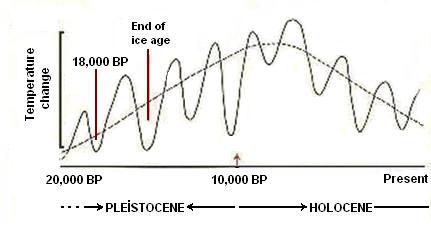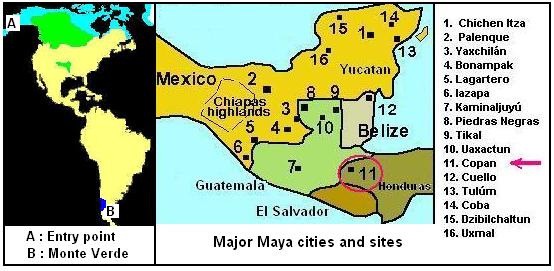|
Several waves of migrations crossed the land-bridge
between Asia and America many thousand years ago and populated
gradually the new continent. An article published in Nature
claims that this fact has now been scientifically proven.
Calculations of sea levels between 18,000 to 9,000 years ago
attest the possibility of such a land-crossing. The article
starts with the following words
(1):
America’s first inhabitants were people from Asia who migrated
over a now submerged land bridge between the two continents.
Another recent archeological research has established that a
group of people were living at a site called Monte Verde in
southern Chile 12,500 years BP
(2). The article in Nature
Magazine states:
If people had migrated almost to the tip of South America by
12,500 years ago, experts agree they must have begun trekking
south from Alaska before the glaciers retreated from the
American interior.
The periodic temperature-variations in the north hemisphere
during the last 20,000 years have been discussed in Chapter 5,
Climatic Changes. From
the graph (below) we can tell that around 18,000 years BP the
northern regions were cold enough to allow such a crossing.
Even after having crossed the land-bridge people had to move
further south, because ice sheets did not retreat until the
end of the ice-age.

They entered from point A shown on the map below-left and
reached Monte Verde (blue point B) within the next 6,000
years. But not all of them went all the way to the south. By
4,600 BP the Olmec people of Mesoamerica attained an advanced
level of civilization exhibiting city life, refined art and
architectural design, and even developed a writing system (see
previous Chapter 27).
The languages of the Americas have been classified in three
main groups. Joseph Greenberg and colleagues have proposed
that the three Native American language families –Amerind,
Na-Dene and Eskimo-Aleut- derive from three separate
migrations from Asia (3). The earliest migrants spoke many
different, but interrelated Asiatic (Altaic) languages, which
have been labeled as “Amerind” a name derived from American-Indian
shown in yellow on the map. The green region has been the area
where tribes speaking Na-Dene or equivalently Atapascan
settled and the light blue region extending from Alaska to
Greenland is the area of Eskimo-Aleut speakers (see Chapter 2,
Diversification of Languages).
Instead of trying to read the complex Maya scriptures, which
needs a special expertise, a simpler approach would be to try
to decipher the toponymy of the Yucatan cities and sites. City
names certainly do have a meaning, but nobody until today ever
tried to give an etymological explanation of the city-names,
or at least I have not come across of such an approach. On the
map below-right we see the names and locations of the major
Maya cities and sites.

Here is my own understanding of some Maya city names:
Chichen Itza:
In the previous chapter:
The Maya word
Tchich
was found to
be
equivalent in meaning and sound to the Turkish word “Çýk”
(pronounced as tchyck)
meaning
Augment,
Climb. The equivalent of “ckichen” is “chykan” in Turkish,
therefore Chichen Itza means “The elevated or superior Itza”.
Tikal:
“Tik” is one of the earliest root-words originating from the
Proto-language, meaning “single, unique” which evolved
to mean “finger” and “hand” (4). In all Altaic languages
(Turkish, Uighur, Chuvash, Chagatai) “tek” means
single.
In the Eskimo-Aleut languages “tik” means the
index finger.
In Chinese “tiek” means one. In Atapascan languages
“tek” and “tikhi” mean again one. In Amerind languages
the Mixe say “tuk” and the Quiche Maya say “tik” for
one.
Therefore, Tikal means “The single one“, or “Be
unique” since the suffix –al exists in Turkish in the form
of –il. Thus Tikal is the equivalent of “tekil” and means
“singular” or “one of a kind”.
Copan:
In Turkish the same word exists as “Kopan”, meaning “the
breakaway one”. This is a valid name for this city, which
is far from the main Maya cities as shown on the map above.
Tulum:
The word “tul”, already mentioned in the last chapter, means
“full” and is found as “dolu” or “tolu” in Turkish. Therefore,
“Tulum” means “filled up” or “crowded”, a perfect name for a
city located by the seashore. A further meaning for “tulum” is
“a filled-up animal skin”, which is also used for “bagpipe”,
an animal skin filled-up with air.
Uxmal:
This name pronounced as “Ushmal” or “Uchmal” contains the
root-word “uch” meaning both “tip” and also “leader”, already
mentioned in Chapter 10, Etruscan Inscriptions.
“Uchmak” meant “heaven” or “high above” in ancient Turkish.
For sure Uxmal was one of the most important Maya cities. The
so called governor’s palace or the residence of the Maya king
is described in the following words by Lewis Spence
(5).
The palace occupies three successive colossal terraces, and
its frieze runs in a line of 100 ms, and is divided into
panels, each of which frames a gigantic head of priest or
deity.
Therefore,
Uxmal
means “the leader city” or “the capital city”.
Without going into more detail on the city names let us turn
our attention to the Maya architecture. The inhabitants of
Yucatan built stepped pyramids in every Maya city and used
them for burying their king, worshiping the sun-god and making
blood rituals and sacrifices.
The Maya had also a very intricate calendar
system. The Maya time-keeping involved several interlocking
cycles, some of which tracked astronomical events while others
seemingly followed abstract time intervals. Maya priests,
who conducted the sacred rituals, were also fervent stargazers
and decided on the timing of important events basing
themselves on both their complicated calendar as well as on
the position of the stars. A solar day in Mayan is “kin”
and is “gün” in Turkish, while the sun in Mayan is “kinish”
and is “günesh” in Turkish. Such similarities can
certainly not be coincidental.
Below we see some Maya pyramids. They are all built on flat
land and are fulfilling the role of mountains, lacking in the
region. In the new world as well as in China and Egypt the
need for pyramid building stemmed from the same desire of
approaching the sun. This wish for worshiping the sun-god
evolved from simple earth-mounds to advanced architectural
stone structures and is found also in the Biblical story
“Tower of Babel”.

The Maya culture and history is part of our forgotten past and
needs to be rediscovered.
|